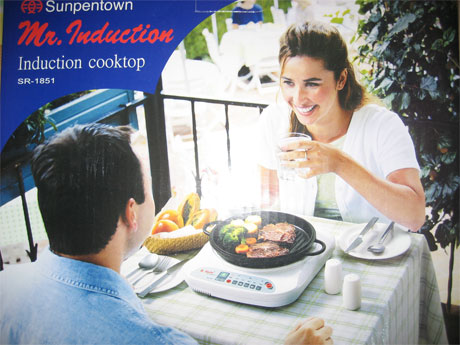Background
Ever since I had heard about magnetic induction cooktops I had been keenly interested in when these devices would enter into use in the common, consumer sphere. Being scared by price tags in the thousands of dollars, I knew my gas range wasn’t going to be getting the boot any time soon.
That’s why I was so happy when I friend told me that you could buy individual induction cooktops at a reasonable price from Sunpentown. Sure, it’s only equivalent to one burner, but for 90% of the cooking I do that is sufficient, so I can at least offset natural gas usage 90% of the time.
Either way, I won’t lie, I was very excited to get my hands on the bleeding edge of energy efficient kitchen appliance. There was one snag though: the cookware. A lot of saucepans will come labeled as stainless steel when they’re really only plated with stainless. This makes the pans look pretty, but many still won’t work with the induction cooker because it can only work with magnetic pots and pans. For this reason I ended up with some new stuff I got off amazon for fairly cheap. Just be warned.

Unit Specs
Here are the specs on the SR-1851 model, straight from the product site.
- Dual functions: COOK (adds heat) and WARM (maintain temperature)
- 9 power settings (260 ~ 1200W)
- 9 temperature/keep warmsetting (120 ~ 420°F)
- Up to 99 minutes of timer setting
- Smartscan technology
- Ceramic-glass surface made in Japan
- Energy efficiency: 83%
- Auto shut-off protection
- Overheat protection
- ETL
The cooktop does use 1.2kW on full blast, which is what it’s rated for. This puts it on par with your average small microwave (or a bit below mine, which is rated for 1.5kW).
Cooking
Obviously we care about energy conservation here at EcoRenovator, but let’s be real, cooking is cooking. If something doesn’t do as good of a job, or just can’t do the job at all, then we’re going to be inclined to stick with the option that uses more energy but actually accomplishes the task. That said, performance wasn’t an issue with this unit.
While heating water, I could discern little if no difference between the conventional stovetop and the induction cooker. Sure, it couldn’t keep up with the high output burner on my gas range, but then I didn’t really expect it to be able to. If I ever need to heat up a lot of something really fast, that will remain my choice.
Besides heating, the induction cooktop offered good, numerical temperature control, which is useful not only for making sure you’re not cooking things too hot, but also having a memorable setting during cooking. Finally, the keep warm ability of the cooktop was very useful for things like curries and events like the occasional potluck, where you often have people going back for second but don’t want to leave a burner on.
The digital controls were intuitive and incredibly easy to use, and made getting used to the cooktop an incredibly quick process. At first I had some trouble when I accidentally put on an aluminum pan and it wouldn’t turn on, but once I tossed the cast iron skillet on it worked like a charm. My only complaint would be the soft noise of the fan during use, which, honestly, isn’t noticeable unless it’s otherwise quiet in the room.
Energy Use
Obviously, I can’t measure gas usage in the same, direct way that I can measure the cooktop’s electricity use with a Kill-A-Watt, but there is really no question of whether magnetic induction is more efficient or not. Because induction cookers only heat other magnetic objects, there is no waste heat like you get with gas flames. The magnetic induction is also more efficient than burning natural gas (83% efficient according to Sunpentown).
However, I won’t bore you with that talk, rather I’ll just give you a quick summary of how much energy the unit actually users are various temperature levels and such:
- 120F: ~270 watts
- 190F: ~575 watts
- 250F: ~690 watts
- 320F: ~810 watts
- 420F: ~1200 watts
To bring a pot of water to boil for tea just now, using the highest setting, it took .14 kW. With power at about 8 cents per kwh around here, that means it cost about a cent in electricity to make my tea. Not bad.
Just be sure to unplug since it draws 3-4 watts in standby if left plugged in!
Overall Impressions
The SR-1851 is definitely a great buy for the value, especially if you considerable the comparable energy use numbers with gas. I’m sure everyone’s price for energy will vary, but magnetic induction is definitely the most efficient thing out there, and speaking from my own, personal experience, this unit is worth picking up, especially with the holidays right around the corner.



{ 2 trackbacks }
Comments on this entry are closed.